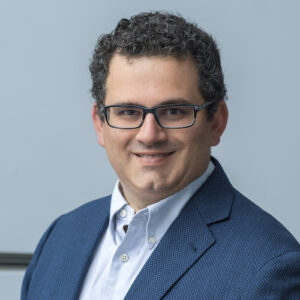
RYAN ZURAKOWSKI
Professor and Chair
Ryan Zurakowski, Ph.D.
Department Chair
Professor
Ammon Pinizzotto Biopharmaceutical Innovation Center
590 Avenue 1743, Ste 413
Newark, DE 19713
E: ryanz@udel.edu
EDUCATION
- Ph.D. in Electrical and Computer Engineering, University of California, Santa Barbara
- M.S. in Electrical and Computer Engineering, University of California, Santa Barbara
- B.S. in Electrical Engineering, University of California, Santa Barbara
RESEARCH AREAS
- Mathematical Modeling
- Cryptic HIV Replication
- Information-Optimal Experiment Design
- Censored-Data Estimation
AREAS OF SPECIAL INTEREST
Dr. Zurakowski’s group develops mathematical models of diseases. By understanding the way that viruses and cells interact, we can learn about the behavior of things we cannot measure from the behavior of things we can. Using models and methods we developed, we have been able to prove that patterns of dead-end HIV DNA circles seen after a particular drug is given to HIV patients prove that HIV continues to replicate in hidden regions of the human body even when HIV medicines have stopped all directly measurable replication. The methods we developed to study HIV can also be applied to traditional engineering applications.
The models we develop allow us to suggest novel experiments that reveal otherwise unmeasurable disease behaviors. We validate our models against clinical and in vitro data using Bayesian inference techniques. The measurements used in our applications are subject to measurement uncertainties of a type not seen in traditional engineering applications. The data is also routinely subject to censoring. In order to accurately use the information present in this kind of data, we also develop novel models of uncertainty.
We have used the methods described above to make a number of significant contributions to the understanding of HIV disease. Using treatment interruption data collected by our collaborators at the IRSI-Caixa AIDS research foundation in Barcelona, Spain, we published the first direct estimates of HIV drug efficacy and residual viremia. Using data from an integrase inhibitor intensification study, also by our collaborations in Barcelona, we were able to demonstrate the presence of persistent, efficient, cryptic viremia in a subset of treated HIV patients with no measurable virus. This finding was validated by a subsequent experiment by our collaborators at the University of California, San Francisco. We have also applied our novel Bayesian inference methods to data from our collaborators at the Ragon Institute of Harvard, MIT, and Massachusetts General Hospital, allowing them to demonstrate that a novel subset of T Cells exhibits order of magnitude higher infection rates than any other known subtype. The findings discussed here are already influencing the direction of HIV treatment and cure research.
Many of the system identification techniques we have developed for our disease system studies also have application in guidance and tracking problems. Inspired by the biomedical applications, we have developed the first formulation of the Kalman filter for censored data systems. We are currently applying this novel estimation technique to a number of tracking and surveillance problems of interest to the Army Research Laboratories.
Students and postdocs interested in working with Dr. Zurakowski can expect to develop and apply advanced mathematical and statistical techniques for data analysis and experiment design, and to apply these to novel experimental data from human disease trials. For information about joining the lab, please email Dr. Zurakowski outlining your specific interests and attach a copy of your CV.
SELECTED PUBLICATIONS
Buzon M, et al. Long-term Antiretroviral Treatment Initiated in Primary HIV-1 Infection Affects the Size, Composition and Decay Kinetics of the Reservoir of HIV-1 Infected CD4 T Cells. Journal of Virology (2014); 88(17): 10056-10065.
Buzon M, et al. HIV-1 persistence in CD4+ T cells with stem cell like properties. Nature Medicine (2014); 20: 139-142.
Cardozo EF, Luo R, Piovoso MJ and R Zurakowski. Spatial modeling of HIV cryptic viremia and 2-LTR formation during raltegravir intensification. Journal of Theoretical Biology (2014); 345: 61-69.
Allik B, Ilg M and R Zurakowski. Ballistic Roll Estimation Using EKF Frequency Tracking and Adaptive Noise Cancellation. IEEE Transactions on Aerospace and Electronic Systems. (2013); 49(4): 2546-2553.
Luo R, Cardozo EF, Piovoso MJ, Wu H, Buzon MJ, Martinez-Picado J and R Zurakowski. Modelling HIV-1 2-LTR dynamics following raltegravir intensification. Journal of the Royal Society: Interface (2013); 10(84): 20130186.
Luo R, Piovoso MJ and R Zurakowski. Modeling Uncertainty in Single-Copy Assays for HIV. Journal of Clinical Microbiology (2012); 50(10): 3382-3383.
Luo R, Piovoso MJ, Martinez-Picado J and R Zurakowski. HIV Model Parameter Estimates from Interruption Trial Data Including Drug Efficacy and Reservoir Dynamics. PLoS One (2012); 7(7): e40198.
Cardozo EF and R Zurakowski. Robust Closed-Loop Minimal Sampling Method for HIV Therapy Switching Strategies. IEEE Transactions on Biomedical Engineering (2012); 59(8): 2227-2234.
